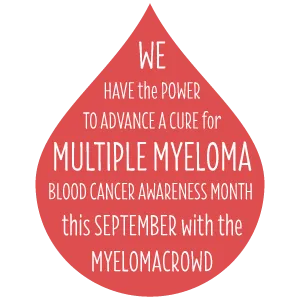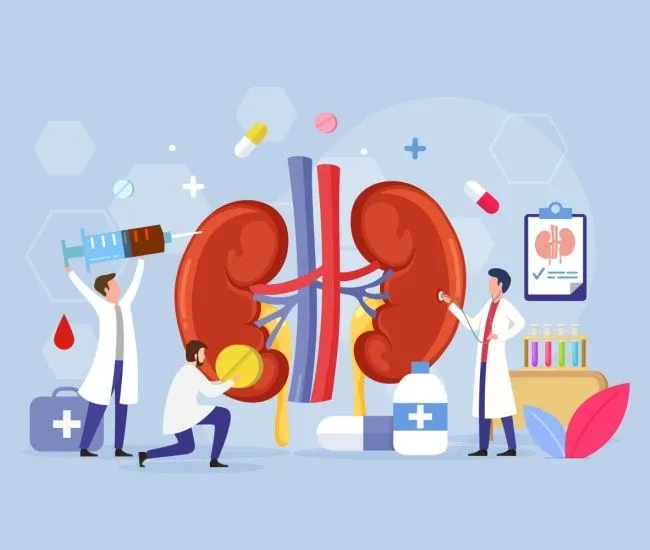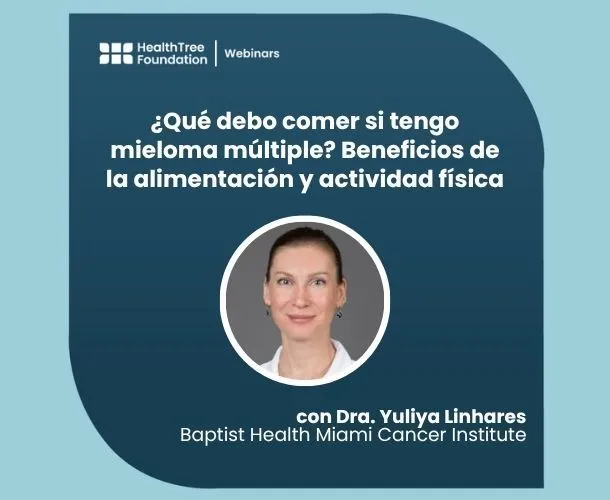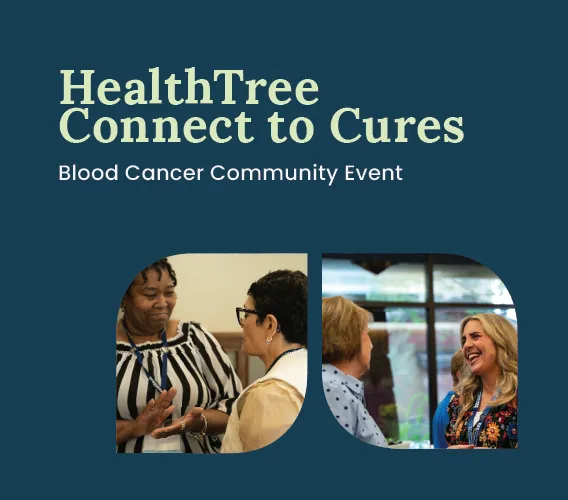Becoming Your Own Biggest Myeloma Advocate (you must!) + Tips

 Blood Cancer Awareness Month: Take Action Thursday
Blood Cancer Awareness Month: Take Action Thursday
BY LIZZY SMITH I have been battling multiple myeloma since January 2012. What a "fun" journey it has been. At diagnosis, I left my husband and filed for divorce, packed up my two daughters and cat, and moved from San Diego to Salt Lake City to seek treatment. Oh, yes, and I quit my corporate job "just like that" too. Since then, I've had tandem auto stem cell transplants (which put me into remission for three years), three solid years of maintenance meds, experienced relapse followed by auto stem cell transplant #3. This last remission lasted just only months. Ugh. With my numbers trending up and my current oncologist scratching his head with no treatment plan that I thought was remotely feasible, I was left feeling bewildered, afraid and frustrated. Honestly, I felt like I was free falling out of an airplane with no backpack. There were all kinds of drugs and combos out there that I had never tried. I knew this, I brought in stacks of studies and clinical trials. I met with the allo transplant doctor and yet that feeling of unease increased. (First note: KNOW your treatment options, new meds, meds in clinical trial, and others in the pipeline. If you can't remember them, make a list or start a file and start printing!) It was time to get started. I was not about to take a baffled look for an answer. And this is HARD. When you have chemo brain, are sick, and you're experiencing panic attacks (like me!), who wants to start setting up consults with other doctors? This means traveling. Did I feel like buying plane tickets, coordinating travel, and going to the airport (the most awful part is the security lines!)? Of course not! I wanted to lie down, take pills, sleep, and wish it away. But this was NOT a luxury that was mine. Over a three week period, I traveled to NIH and Johns Hopkins (flights plus one week stay in hotels) in Washington DC and Baltimore respectively. I got great ideas and wrote them all down. Then Fred Hutchison in Seattle. And Mayo in Scottsdale. Lots of options, similar to each other, but from some of the most cutting-edge myeloma specialist out there. When I got home, I texted my PA. I had a list of seven different meds/combinations in order of best to next. Would they put this plan into place or should I find a new treatment center? They would. Turns out, I was ultimately in charge of my treatment. Relying on my doctors to do this legwork wasn't happening. I had just a couple choices: 1) Remain silent and "go along" into the abyss, or 2) I HAD to advocate for myself. Easy? Heck no! Worth it? I hope so! And beyond that, I came back from all these appointments with a renewed sense of hope and empowerment. I am NOT giving into this disease EVER. If I must go down, I'll do it swinging, advocating, educating, and trying to make a difference. I plan to be around along time and if that means I have to get my sore, tired, fatigue-filled body on a plane, then I suppose I will somehow find the strength, finances and wherewithal to do it. Here are my tips:
- Don't take "no" for an answer.
- Ask your treatment team tough questions and expect/demand answers. If they can't get you answers, find new doctors.
- Stay on top of what treatments the best researchers are studying. Keep a list of them and talk to your doctor. You will be surprised how little many doctors know about the pipeline.
- Get into clinical trials.
- Stay as healthy as you can (that means eating as well as possible and get exercise).
And then hope and pray. To start learning more about open myeloma clinical trials, click here for an easy-to-use clinical trial find by SparkCures. Find Myeloma Clinical Trials
 Blood Cancer Awareness Month: Take Action Thursday
Blood Cancer Awareness Month: Take Action Thursday
BY LIZZY SMITH I have been battling multiple myeloma since January 2012. What a "fun" journey it has been. At diagnosis, I left my husband and filed for divorce, packed up my two daughters and cat, and moved from San Diego to Salt Lake City to seek treatment. Oh, yes, and I quit my corporate job "just like that" too. Since then, I've had tandem auto stem cell transplants (which put me into remission for three years), three solid years of maintenance meds, experienced relapse followed by auto stem cell transplant #3. This last remission lasted just only months. Ugh. With my numbers trending up and my current oncologist scratching his head with no treatment plan that I thought was remotely feasible, I was left feeling bewildered, afraid and frustrated. Honestly, I felt like I was free falling out of an airplane with no backpack. There were all kinds of drugs and combos out there that I had never tried. I knew this, I brought in stacks of studies and clinical trials. I met with the allo transplant doctor and yet that feeling of unease increased. (First note: KNOW your treatment options, new meds, meds in clinical trial, and others in the pipeline. If you can't remember them, make a list or start a file and start printing!) It was time to get started. I was not about to take a baffled look for an answer. And this is HARD. When you have chemo brain, are sick, and you're experiencing panic attacks (like me!), who wants to start setting up consults with other doctors? This means traveling. Did I feel like buying plane tickets, coordinating travel, and going to the airport (the most awful part is the security lines!)? Of course not! I wanted to lie down, take pills, sleep, and wish it away. But this was NOT a luxury that was mine. Over a three week period, I traveled to NIH and Johns Hopkins (flights plus one week stay in hotels) in Washington DC and Baltimore respectively. I got great ideas and wrote them all down. Then Fred Hutchison in Seattle. And Mayo in Scottsdale. Lots of options, similar to each other, but from some of the most cutting-edge myeloma specialist out there. When I got home, I texted my PA. I had a list of seven different meds/combinations in order of best to next. Would they put this plan into place or should I find a new treatment center? They would. Turns out, I was ultimately in charge of my treatment. Relying on my doctors to do this legwork wasn't happening. I had just a couple choices: 1) Remain silent and "go along" into the abyss, or 2) I HAD to advocate for myself. Easy? Heck no! Worth it? I hope so! And beyond that, I came back from all these appointments with a renewed sense of hope and empowerment. I am NOT giving into this disease EVER. If I must go down, I'll do it swinging, advocating, educating, and trying to make a difference. I plan to be around along time and if that means I have to get my sore, tired, fatigue-filled body on a plane, then I suppose I will somehow find the strength, finances and wherewithal to do it. Here are my tips:
- Don't take "no" for an answer.
- Ask your treatment team tough questions and expect/demand answers. If they can't get you answers, find new doctors.
- Stay on top of what treatments the best researchers are studying. Keep a list of them and talk to your doctor. You will be surprised how little many doctors know about the pipeline.
- Get into clinical trials.
- Stay as healthy as you can (that means eating as well as possible and get exercise).
And then hope and pray. To start learning more about open myeloma clinical trials, click here for an easy-to-use clinical trial find by SparkCures. Find Myeloma Clinical Trials

about the author
Lizzy Smith
Lizzy Smith was diagnosed with myeloma in 2012 at age 44. Within days, she left her job, ended her marriage, moved, and entered treatment. "To the extent I'm able, I want to prove that despite life's biggest challenges, it is possible to survive and come out stronger than ever," she says.
More on Navigating Your Health
Trending Articles
Upcoming Events




Get the Latest Multiple Myeloma Updates, Delivered to You.
By subscribing to the HealthTree newsletter, you'll receive the latest research, treatment updates, and expert insights to help you navigate your health.
Together we care.
Together we cure.
3x Faster.











